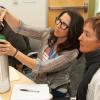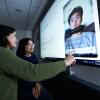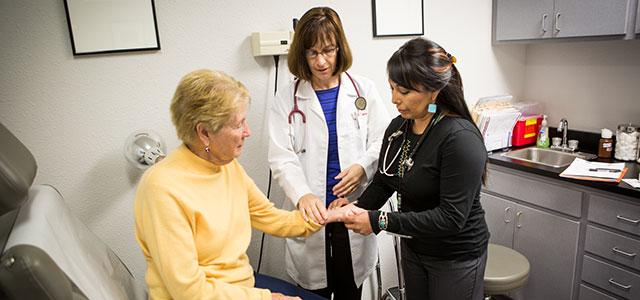
Physician Patricia O'Connor (center) and nurse practitioner student Christina Interpreter examine a patient (photos by Elisabeth Fall).
Diabetes Fellowship Program Provides Intensive Training to Advanced Practice Nursing Students
To celebrate the 150th birthday of UC San Francisco and the role that the School of Nursing has played in this unique health sciences institution, Science of Caring has planned a series of stories that focus on important, often seminal contributions that the School has made to health care education, delivery and research.
This story kicks off the series by profiling the first cohort of diabetes fellows – part of a diabetes minor that is among the first of its kind in the country.
A 2010 analysis by the Centers for Disease Control (CDC) predicts that diabetes will affect up to one in three US adults by 2050 if current trends continue. The disease is chronic, life-changing and, sometimes, overwhelming.
At UCSF School of Nursing, four advanced practice nursing students are the first to take advantage of a unique program that aims to prepare them to work with a diverse population of diabetes patients.
The Madison Clinic Peggy Huang Diabetes Nurse Fellows – Cadelba Lomeli-Loibl, Grace Moore, Christina Interpreter and Gabriela Valencia – have each received scholarships to pursue an intensive course of study in diabetes as part of an anonymous $1.5 million gift that established the school’s academic minor in diabetes. The fellowship allows them to complete the minor (among the first of its kind in the country) and to participate in extensive clinical experiences in both primary care and specialty clinics around the state.
Different Paths, Shared Commitment
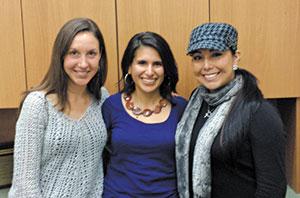 Grace Moore, Cadelba Lomeli-Loibl, Christina Interpreter The four come from disparate backgrounds but share a commitment to caring for patients with diabetes. For both Interpreter and Valencia, the impact the disease has had on their respective communities spurred them to want to learn more.
Grace Moore, Cadelba Lomeli-Loibl, Christina Interpreter The four come from disparate backgrounds but share a commitment to caring for patients with diabetes. For both Interpreter and Valencia, the impact the disease has had on their respective communities spurred them to want to learn more.
“I’m Hopi and Navajo, and there’s such a high prevalence of diabetes within the Native American population, particularly in Arizona, where I’m from,” says Interpreter. Later, when she became a member of the Mayo Clinic transplant team, she realized that she wanted to go back to primary care and to serve her community by becoming a nurse practitioner and, she hopes, working in the Indian Health Service.
Valencia was working with immigrants in a free clinic as a volunteer Spanish interpreter when she realized she wanted to bring her own immigrant experience to health care. She found herself driven to help people – particularly Latinos, who are disproportionately affected by diabetes – manage a complex disease in challenging settings. She says, “I know what it’s like when you don’t have a lot of money to buy food, or your work environment is such that you don’t have the opportunity to have an adequate lunch.”
Moore comes to the fellowship from a different perspective. A community health worker before nursing school, she originally thought she’d want to work in public health policy or programming, but interacting with patients with diabetes moved her to follow in her supervisor’s footsteps and become a nurse practitioner: “Seeing her in that role made me realize that [working with patients] was where my passion was,” she says.
Lomeli-Loibl had a similar experience working as a nurse at a community clinic with mostly Latino immigrants; diabetes was a major factor in the daily lives of many of her patients. “I was doing a lot of counseling for nutrition and exercise, but I had never been formally trained in diabetes management,” she says.
Developing Competency in Behavioral Management
Regardless of the original motivation, all four were seeking a way to develop competency in managing diabetes when the School announced its diabetes minor. As Valencia puts it, “I said to myself, ‘My patients need this.’”
While primary care clinicians are expected to have a breadth of knowledge, expertise in diabetes pays additional dividends because it affects such a large – and growing – segment of the population, and because the effects of optimal (or suboptimal) management can have a significant impact on overall health. Moreover, treating patients with diabetes requires not only clinical knowledge, but an understanding of behavioral management – a skill set that can be applied to many other conditions and aspects of care. “It involves so many lifestyle and psychosocial elements, so developing a mastery of diabetes informs management of so many other things,” says Moore.
In addition to in-depth courses in the clinical management of adults and children with diabetes, the new diabetes minor has a particular emphasis on the behavioral management piece, says Maureen McGrath, who directs the program, because behavioral management is one of the most challenging aspects of diabetes for provider and patient. “Getting people to set goals involves a negotiation, understanding where a patient is, but also feeling confident and competent to direct them towards a goal,” she says.
“We train students to consider all the psychosocial factors that affect people’s ability to make health choices and take care of their diabetes,” says Carolina Espinosa Noya, clinical faculty in the Department of Family Health Care Nursing and third-year doctoral student, who teaches in the minor. Students complete a course in family and behavioral approaches to the condition, which includes a lab that requires students to pair up and set SMART (specific, measurable, assignable, realistic, time-related) goals for behavioral change. There is also a four-day simulation during which students are asked to live as if they have diabetes – including measuring blood sugars and mimicking insulin treatment with saline injections – and McGrath presents them with a series of real-life problems to solve.
During Moore’s simulation, for example, she was working in clinic and received an email from McGrath telling Moore she “had” low blood sugar. After Moore took the glucose tablets she’d brought, she received another message telling her that she hadn’t responded to treatment. “I had to think about what it would be like to suddenly feel like I couldn’t think, and I had to scavenge to find some candy when I wasn’t hungry because I’d only packed for one treatment of a low. It was really challenging,” she says.
McGrath uses her own diabetes as a teaching tool – she’s had type 1 diabetes since age 12 – and she has been fortunate to have two students interested in the minor who also have diabetes and can help their peers understand what it’s like to live with the disease 24/7. “Rather than a theoretical problem with diet, we had real situations,” she says.
Unlearning Judgment and Combating Stigma
Part of the goal is to help students develop problem-solving skills related to diabetes, but another key component, says McGrath, is maintaining empathy and unlearning the judgment that often surrounds diabetes, which she says can be harder for students than learning how to manage medication. People with diabetes, particularly type 2, are often blamed for their disease, and health care providers are as prone to this kind of bias as anyone else. Says Lomeli-Loibl, “We think, ‘Why didn’t you eat better? Why didn’t you exercise?’ It’s really important that we realize that judgment isn’t effective, and it’s not going to help people manage their own health.”
Moreover, it can backfire. Several studies have cited clinicians’ “threatening” patients with insulin if they are perceived as noncompliant with other therapeutic recommendations, such as lifestyle changes. Such threats may be a factor in patients’ resistance to using insulin, a phenomenon known as “psychological insulin resistance.” Patients may feel they have “failed” if a provider prescribes insulin. Interpreter notes that there is a particular stigma associated with insulin use in the Native American community. “It’s important to educate them about why they’re taking insulin and how it can help them, rather than having it be a negative,” she says.
Getting Hands-On Experience
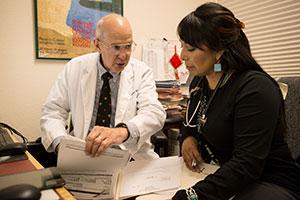 Interpreter with physician Michael O'Connor The fellows, now in their second year of the minor, have begun a series of rotations in community primary care and specialty clinics around the state. Interpreter has worked with children in UCSF’s Madison Clinic for Pediatric Diabetes. “It was the first time I’d worked with type 1 diabetes,” she says. “I gained so much respect for the kids – they know so much, and I’m still learning.” Lomeli-Loibl has had placements in both a community primary care and diabetes specialty clinics. Moore’s experience in a Marin County community clinic that was piloting a hybrid approach – doing primary care in the mornings and reserving Thursday afternoons for diabetes management – has prompted her to write her comprehensive paper (for her master’s degree) on expanding that model by incorporating community health workers into the primary care team, which allows patients to have support from peers who have diabetes in creating action plans and working on SMART goals to improve diabetes management.
Interpreter with physician Michael O'Connor The fellows, now in their second year of the minor, have begun a series of rotations in community primary care and specialty clinics around the state. Interpreter has worked with children in UCSF’s Madison Clinic for Pediatric Diabetes. “It was the first time I’d worked with type 1 diabetes,” she says. “I gained so much respect for the kids – they know so much, and I’m still learning.” Lomeli-Loibl has had placements in both a community primary care and diabetes specialty clinics. Moore’s experience in a Marin County community clinic that was piloting a hybrid approach – doing primary care in the mornings and reserving Thursday afternoons for diabetes management – has prompted her to write her comprehensive paper (for her master’s degree) on expanding that model by incorporating community health workers into the primary care team, which allows patients to have support from peers who have diabetes in creating action plans and working on SMART goals to improve diabetes management.
Valencia’s most recent rotation had her working with women who had gestational diabetes, which she says gave her ideas that she can apply to other patients. The time it can take to make big lifestyle changes is a luxury women with gestational diabetes don’t have. “We have to find ways to implement minor changes,” Valencia says. “So we break things down in a way that’s more manageable.”
By the time they complete the two-year fellowship, the students will be well prepared to meet the primary care needs of patients with and without diabetes, whatever practice setting they choose. That’s good news for the fellows’ future patients, particularly in underserved communities that desperately need both primary care providers and diabetes care. “Our students will have the expertise to bring high quality diabetes care to people who have no access to specialists,” says Noya.
Looking to the Future
Both Lomeli-Loibl and Valencia plan to serve Spanish-speaking communities. Interpreter would like to join the Indian Health Service, a federal program that provides health care to Native Americans and Alaska Natives, to bring evidence-based diabetes care to a community that is deeply affected by the disease. Moore is unsure what path she’ll take, but wherever she finds herself, she hopes to be a “diabetes champion,” both helping patients and working with other clinicians and community health workers to stay up to date with evidence-based practice.
McGrath hopes that these four – and the 11 other students completing the minor – will be the first of many such “champions” trained through the program, thanks to the generosity of the donor. “There are so many more people benefiting than just the students,” says Valencia. “It’s a wonderful investment.”

